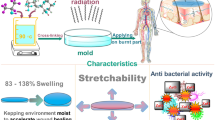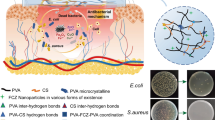Abstract
A topical wound dressing system containing ciprofloxacin was designed through the fabrication of two hydrogels by coupling gelatin with ethyl vanillin and its composite with polyvinyl alcohol using electron beam irradiation. The composite hydrogel films were loaded with ciprofloxacin by the equilibrium swelling method and its release was investigated in various mediums. The influence of factors affecting the loading and release of the drug as well as the morphology and chemical structure of hydrogels were considered. The amount of drug released from composite hydrogels to simulated wound fluid was more than that in pH of 2.2 solution. The loaded drug on the composite hydrogels was slowly released in the simulated wound fluid medium; thus, about 90% of it was released in 19.5 h. The kinetics and mechanism of ciprofloxacin release from composite hydrogels in different media followed the Higuchi or Korsmeyer–Peppas model and non-Fickian diffusion mechanism, respectively. The cytotoxicity analyses verified the non-toxicity of the synthesized hydrogels. Also, for loaded composite hydrogels, acceptable growth inhibition was observed toward Staphylococcus aureus and Escherichia coli bacteria. Based on these results, the synthesized hydrogels seem to be useful for the fabrication of antibacterial polymeric wound dressing with slow drug release of up to 19.5 h.
Graphical abstract












Similar content being viewed by others
References
Khan SA, Ali Shah LA, Shah M (2021) Engineering of 3D polymer network hydrogels for biomedical applications: a review. Polym Bull. https://doi.org/10.1007/s00289-021-03638-5
Ullah F, Othman MBH, Javed F et al (2015) Classification, processing and application of hydrogels: a review. Mater Sci Eng C 57:414–433
Abu-Elella MH, Hanna DH, Mohamed RR, Sabaa MW (2022) Synthesis of xanthan gum/trimethyl chitosan interpolyelectrolyte complex as pH-sensitive protein carrier. Polym Bull 79:2501–2522
Ngwuluka NC, Abu-thabit N, Uwaezuoke O, Erebor JO, Ilomuanya M, Mohamed RR, Soliman MA, Abu-Elella MH (2021) Natural Polymers in Micro-and Nanoencapsulation for Therapeutic and Diagnostic Applications: Part II: Polysaccharides and proteins. In: Abu-thabit N (ed) Nano- and microencapsulation techniques and applications. IntechOpen, UK, pp 55–98
Sahiner M, Alpaslan D, Bitlisli BO (2014) Collagen-based hydrogel films as drug-delivery devices with antimicrobial properties. Polym Bull 71:3017–3033
Pettinelli N, Rodríguez-Llamazares S, Bouza R et al (2020) Carrageenan-based physically crosslinked injectable hydrogel for wound healing and tissue repairing applications. Int J Pharm 589:119828
Gunes OC, Albayrak AZ (2020) Antibacterial Polypeptide nisin containing cotton modified hydrogel composite wound dressings. Polym Bull 78:6409–6428
Dadashzadeh A, Imani R, Moghassemi S, Omidfar K, Abolfathi N (2020) Study of hybrid alginate/gelatin hydrogel-incorporated niosomal Aloe vera capable of sustained release of Aloe vera as potential skin wound dressing. Polym Bull 77:387–403
Relleve LS, Gallardo AKR, Tecson MG, Luna JAA (2021) Biocompatible hydrogels of carboxymethyl hyaluronic acid prepared by radiation-induced crosslinking. Radiat Phys Chem 179:109104
Rodoplu S, Celik BE, Kocaag B et al (2021) Dual effect of procaine-loaded pectin hydrogels: pain management and in vitro wound healing. Polym Bull 78:2227–2250
Zheng X, Zhang Q, Liu J et al (2016) A unique high mechanical strength dialdehyde microfibrillated cellulose/gelatin composite hydrogel with a giant network structure. RSC Adv 6:71999–72007
Ghosh SK, Das A, Basu A et al (2018) Semi-interpenetrating hydrogels from carboxymethyl guar gum and gelatin for ciprofloxacin sustained release. Int J Biol Macromol 120:1823–1833
Qazvini NT, Zinatloo S (2011) Synthesis and characterization of gelatin nanoparticles using CDI/NHS as a non-toxic cross-linking system. J Mater Sci Mater Med 22:63–69
Shetye SP, Godbole A, Bhilegaokar S et al (2015) Hydrogels: introduction, preparation, characterization and applications. Hum J 1:47–71
Tavakol M, Dehshiri S, Vasheghani-Farahani E (2016) Electron beam irradiation crosslinked hydrogels based on tyramine conjugated gum tragacanth. Carbohydr Polym 152:504–509
Prusty K, Swain SK (2018) Nano silver decorated polyacrylamide/dextran nanohydrogels hybrid composites for drug delivery applications. Mater Sci Eng C 85:130–141
Zhao L, Xu L, Mitomo H et al (2006) Synthesis of pH-sensitive PVP/CM-chitosan hydrogels with improved surface property by irradiation. Carbohydr Polym 64:473–480
Bardajee GR, Pourjavadi A, Soleyman R et al (2010) Gamma irradiation mediated synthesis of a new superabsorbent hydrogel network based on poly (acrylic acid) grafted onto salep. J Iran Chem Soc 7:652–662
Zhang S, Wang W, Wang H et al (2014) Synthesis and characterisation of starch grafted superabsorbent via 10 MeV electron-beam irradiation. Carbohydr Polym 101:798–803
Benbettaïeb N, Karbowiak T, Brachais CH et al (2015) Coupling tyrosol, quercetin or ferulic acid and electron beam irradiation to crosslink chitosan–gelatin films: a structure–function approach. Eur Polym J 67:113–127
Lević S, Obradović N, Pavlović V et al (2014) Thermal, morphological, and mechanical properties of ethyl vanillin immobilized in polyvinyl alcohol by electrospinning process. J Therm Anal Calorim 118:661–668
Moghaddam RH, Shabani AMH, Dadfarnia S (2019) Synthesis of new hydrogels based on pectin by electron beam irradiation with and without surface modification for methylene blue removal. J Environ Chem Eng 7:102919
Moghaddam RH, Dadfarnia S, Shabani AMH et al (2019) Electron beam irradiation synthesis of porous and non-porous pectin based hydrogels for a tetracycline drug delivery system. Mater Sci Eng C 102:391–404
Moghaddam RH, Dadfarnia S, Shabani AMH et al (2019) Synthesis of composite hydrogel of glutamic acid, gum tragacanth, and anionic polyacrylamide by electron beam irradiation for uranium (VI) removal from aqueous samples: equilibrium, kinetics, and thermodynamic studies. Carbohydr Polym 206:352–361
Pal K, Banthia AK, Majumdar DK (2007) Preparation and characterization of polyvinyl alcohol-gelatin hydrogel membranes for biomedical applications. AAPS PharmSciTech 8:E142–E146
Singh B, Varshney L, Francis S (2017) Designing sterile biocompatible moxifloxacin loaded trgacanth-PVA-alginate wound dressing by radiation crosslinking method. Wound Med 17:11–17
Hanna DH, Saad GR (2019) Encapsulation of ciprofloxacin within modified xanthan gum-chitosan based hydrogel for drug delivery. Bioorg Chem 84:115–124
Singh B, Varshney L, Francis S (2017) Synthesis and characterization of tragacanth gum based hydrogels by radiation method for use in wound dressing application. Radiat Phys Chem 135:94–105
Ritger PL, Peppas NA (1987) A simple equation for description of solute release II. Fickian and anomalous release from swellable devices. J Control Release 5:37–42
Hossieni-Aghdam SJ, Foroughi-Nia B, Zare-Akbari Z et al (2018) Facile fabrication and characterization of a novel oral pH-sensitive drug delivery system based on CMC hydrogel and HNT-AT nanohybrid. Int J Biol Macromol 107:2436–2449
Singh B, Varshney L, Francis S (2016) Designing tragacanth gum based sterile hydrogel by radiation method for use in drug delivery and wound dressing applications. Int J Biol Macromol 88:586–602
Goda ES, Abu-Elella MH, Sohail M, Singu BS, Pandit B et al (2021) N-methylene phosphonic acid chitosan/graphene sheets decorated with silver nanoparticles as green antimicrobial agents. Int J Biol Macromol 182:680–688
Abu-Elella MH, Sabaa MW, Hanna DH, Abdel-Aziz MM, Mohamed RR (2020) Antimicrobial pH-sensitive protein carrier based on modified xanthan gum. J Drug Deliv Sci Technol 57:101673
Lu Q, Zhang S, Xiong M et al (2018) One-pot construction of cellulose-gelatin supramolecular hydrogels with high strength and pH-responsive properties. Carbohydr Polym 196:225–232
Bardajee GR, Pourjavadi A, Ghavami S et al (2011) UV-prepared salep-based nanoporous hydrogel for controlled release of tetracycline hydrochloride in colon. J Photochem Photobiol B Biol 102:232–240
Cortesi R, Nastruzzi C, Davis SS (1998) Sugar cross-linked gelatin for controlled release: microspheres and disks. Biomaterials 19:1641–1649
Jalaja K, Naskar D, Kundu SC et al (2015) Fabrication of cationized gelatin nanofibers by electrospinning for tissue regeneration. RSC Adv 5:89521–89530
Prusty K, Swain SK (2019) Release of ciprofloxacin drugs by nano gold embedded cellulose grafted polyacrylamide hybrid nanocomposite hydrogels. Int J Biol Macromol 126:765–775
Marchesan S, Qu Y, Waddington LJ et al (2013) Self-assembly of ciprofloxacin and a tripeptide into an antimicrobial nanostructured hydrogel. Biomaterials 34:3678–3687
Das D, Pal S (2015) Dextrin/poly (HEMA): pH responsive porous hydrogel for controlled release of ciprofloxacin. Int J Biol Macromol 72:171–178
Prusty K, Biswal A, Biswal SB et al (2019) Synthesis of soy protein/polyacrylamide nanocomposite hydrogels for delivery of ciprofloxacin drug. Mater Chem Phys 234:378–389
Author information
Authors and Affiliations
Corresponding authors
Additional information
Publisher's Note
Springer Nature remains neutral with regard to jurisdictional claims in published maps and institutional affiliations.
Rights and permissions
Springer Nature or its licensor holds exclusive rights to this article under a publishing agreement with the author(s) or other rightsholder(s); author self-archiving of the accepted manuscript version of this article is solely governed by the terms of such publishing agreement and applicable law.
About this article
Cite this article
Hafezi Moghaddam, R., Dadfarnia, S., Haji Shabani, A.M. et al. Fabrication of two hydrogels composites through the coupling of gelatin with ethyl vanillin/polyvinyl alcohol using electron beam irradiation for ciprofloxacin delivery. Polym. Bull. 80, 8407–8429 (2023). https://doi.org/10.1007/s00289-022-04456-z
Received:
Revised:
Accepted:
Published:
Issue Date:
DOI: https://doi.org/10.1007/s00289-022-04456-z




